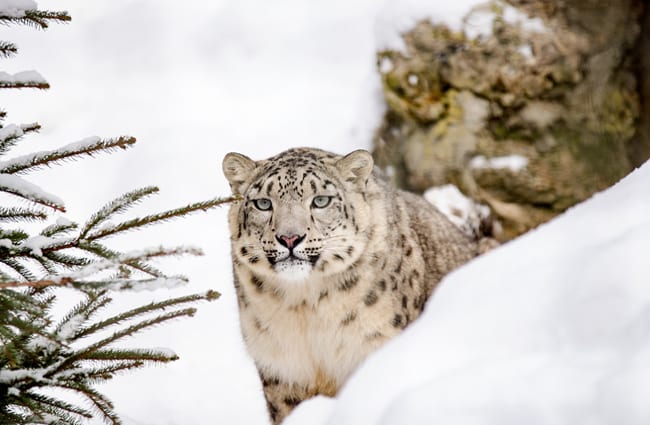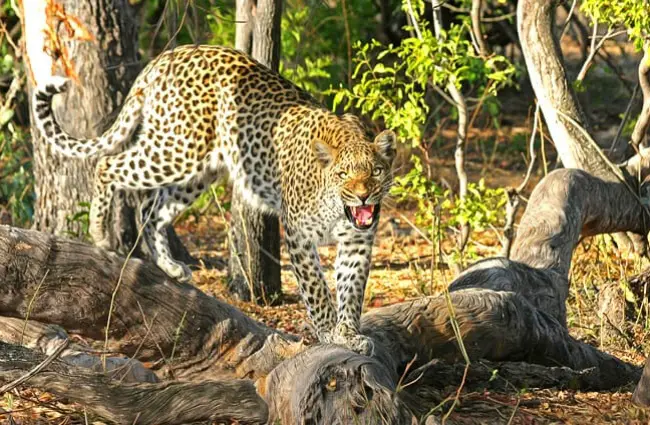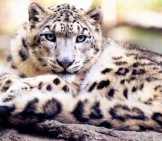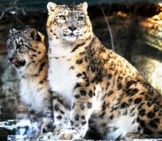Leopards are large cats that live in Africa and across southern Asia. Humans threaten these cats to various extents throughout their range. In fact, because of these threats, leopards no longer live in many of the areas that they used to historically range. These cats are part of the taxonomic genus Panthera, along with lions, tigers, and jaguars. Read on to learn about the leopard.
Description of the Leopard
Leopards are large cats, with light-colored fur, and black spots and rosettes across their entire body. The rosettes look somewhat like hollowed-out spots, and are smaller than those of the jaguar.
Males of the species are larger than the females, and can stand up to 28 in. tall at the shoulder. They can weigh nearly 200 lbs., though females usually weigh much less. Leopards in different regions can vary drastically in size.
Interesting Facts About the Leopard
These big cats are impressive hunters, and quite powerful creatures. humans respect and fear them across their range because of this. Learn more about these interesting cats below.
- The Black Panther – Black panthers are not panthers at all, they are actually leopards. All-black leopards are the cats that we frequently refer to as “black panthers.” The cats are all black because of their genetics, and black panthers are actually relatively common in leopards.
- Lots of Leopards – There are eight different subspecies of leopards, and each has its own range and distribution. Some subspecies are rarer than others, as different regions are more plagued by habitat destruction and poaching. The eight subspecies are the African, Indian, Javan, Arabian, Anatolian, Amur, Indochinese, and Sri Lankan leopard.
- Critical Populations – The IUCN lists three subspecies of leopards as Critically Endangered. The Amur, Arabian, and Javan leopard subspecies are all severely depleted. Scientists consider the Amur leopard one of the rarest cats on this planet.
- Treetop Storage – Leopards are powerful predators, but no match against a pride of hungry lions or a particularly ornery tiger. Thankfully for these cats, they exhibit a unique behavior to protect their precious meals from other hungry mouths. When leopards kill a large animal, they use their strong jaws and powerful limbs to drag the kill up into the trees.
Habitat of the Leopard
The preferred habitat of this species varies by subspecies and location. Regardless of location, most leopards like to live in areas with trees for them to hide in.
Their two main habitats are rainforest and savanna. However, they also live in temperate forests, river forests, woodlands, desert edges, and more. Some leopards in India live closer to human habitations, however most leopards stay far from urban areas.
Distribution of the Leopard
These big cats have the widest distribution of any wild cat. However, this does not mean that they are widespread and common in all of their ranges. The IUCN lists many subspecies as endangered.
There are populations of leopards in Africa, the Middle East, India, Nepal, China, Malaysia, Vietnam, Thailand, and portions of Indonesia. Many of these populations have fragmented ranges and declining numbers.
Diet of the Leopard
Leopards are impressive predators, and are capable of hunting prey much larger than themselves. They are carnivores, and eat only meat. Most of their hunting targets animals between 20 and 80 lbs., but they can kill prey up 1,200 lbs. or more!
These cats feed on a huge number of different species. Some common prey includes impala, Thomson’s gazelle, warthog, wildebeest, bushbuck, aardvark, kudu, chital, sambar, gaur, and more. Some leopards even hunt and kill gorillas, but this is less common.
Man-Eaters
It would be foolish to assume that such a dangerous animal could not potentially kill people. There are many instances of leopards killing and even hunting and eating humans. However, these instances are usually rare, and most leopards are quite shy and prefer avoiding humans and urban areas. Leopards that are most likely to hunt humans are the animals that are sick or injured, and unable to capture other prey.
Leopard and Human Interaction
Comparing human injuries to leopard injuries in human-leopard interaction is simply useless. The threat that humans pose to leopards is much greater than the threat that leopards pose to humans.
The IUCN recognizes many subspecies of leopards as Endangered or Critically Endangered, and the species as a whole as Vulnerable. The primary threats to this species are poaching, habitat destruction, and more.
Domestication
Humans have not domesticated leopards in any way.
Does the Leopard Make a Good Pet
No, leopards do not make good pets. This should not need any additional explanation but, leopards can kill small giraffes, you would make an easy snack if you made your pet leopard angry or annoyed.
Leopard Care
In zoos, these cats thrive in large enclosures with a variety of climbing opportunities and hiding places. Zoos provide the cats with a variety of platforms, trees, and artificial rock formations for climbing and hiding.
Zoos have also formulated a ground meat diet for large carnivores with balanced vitamins and nutrients. In addition to this ground meat, keepers also feed them sheep carcasses, bones, thawed rabbits, and more. Zookeepers also provide a variety of toys, hidden food, puzzle feeders, and more, to keep the cats stimulated.
Behavior of the Leopard
Most leopards are solitary, and active at night, though there are some leopards that are active during the day as well. During the daytime, most leopards spend their time snoozing in the tops of trees.
Once the sun begins to go down, the cats move stealthily through their territory in search of prey. They can travel 10 miles or more in a single night, and some even roam up to 40 miles or more!
Reproduction of the Leopard
Mating varies from subspecies to subspecies and region to region. Most leopards have no specific breeding season, and can mate year round. The female leopard is receptive to mating for about a week. Her gestation period is a little over three months, and she usually gives birth to between two and four cubs.
Nearly half of all cubs born will not survive their first year. The mother weans cubs off her milk, and they are self-sufficient at a year old, but they usually stay with their mother until they are around two years old.















![Red Angus Closeup of a beautiful Red Angus cowPhoto by: U.S. Department of Agriculture [pubic domain]https://creativecommons.org/licenses/by/2.0/](https://animals.net/wp-content/uploads/2020/03/Red-Angus-4-238x178.jpg)












![Red Angus Closeup of a beautiful Red Angus cowPhoto by: U.S. Department of Agriculture [pubic domain]https://creativecommons.org/licenses/by/2.0/](https://animals.net/wp-content/uploads/2020/03/Red-Angus-4-100x75.jpg)

